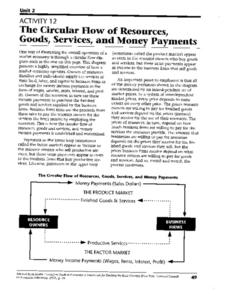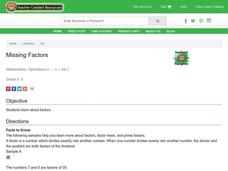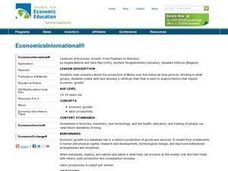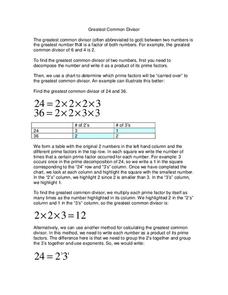Curated OER
Cuisenaire Multiplication
Cuisenaire Rods give learners an excellent strategy as they learn about multiplication. How many ways can they make the same product? Using a target product, learners lay out rods to achieve that number through various factors. This...
Curated OER
The Circular Flow of Resources, Goods, Services, and Money Payments
In this Circular Flow of Resources, Goods, Services, and Money Payments worksheet, students read background information, examine a flow chart, then answer ten questions.
Curated OER
Little Bees, Big Potential
After reading an article on the alfalfa leafcutting bee, learners chart its characteristics alongside those of the honeybee. Then they draw the leafcutter lifecycle. The article provides fascinating reading when studying the role of...
Curated OER
Exploring Multiplication Functions
Fourth graders investigate the terms "factor" and "product." In this mathematics lesson, 4th graders practice solving problems to find the products and factors present in different algebraic expressions.
Curated OER
Missing Factors
Students explore factors. They discuss factors, factor trees and prime factors. Students practice working with and finding various factors and prime factors. They discuss methods used to find factors.
Curated OER
Prime Numbers: Eratosthenes' Sieve
By offering a step-by-step explanation of how to identify prime numbers, this presentation would be a terrific way to give learners a visual example of prime numbers. This is a simple, and easy way, for students to understand the "why"...
Soft Schools
Multiplication Table
Use the multiplication table as an aid for young mathematicians who are learning their multiplication facts. Children can explore the concept of multiplication by using the factors in the far left column and the top row to determine a...
Mrs. Glosser's Math Goodies
Number Theory Worksheet 3
A nine-row data table has novice number crunchers fill in columns for the greatest common factor, least common multiple, product of the two, and product of numbers. The pairs of numbers to work with are all single- and double-digit...
Curated OER
Peanut Butter Broccoli
Fifth graders explore food production by viewing DNA presentations. In this genetic engineering lesson, 5th graders discuss the foods they typically eat at home and how many common foods are engineered in a way that can produce a bigger...
Curated OER
Commutative Cubes
In this commutative property learning exercise, students use number cubes to create equations where they demonstrate the commutative property. Students fill in 8 equations to a chart and answer 3 questions.
Curated OER
Environmental Conditions: Friend or Foe
Students research and answer questions on how organisms are classified and how their needs are met through their environment. They work in small groups and create a poster, chart, rap, PowerPoint, or brochure demonstrating how organisms...
Curated OER
Centuries of Economic Growth: From Feathers to Robotics
Students read scenarios about the production of Bibles over five historical time periods. Working in small groups, students create skits and develop a retrieval chart that is used to analyze factors that impact economic growth.
Curated OER
Time for Prime
Explore prime numbers. Learners use an interactive 100's chart to identify prime numbers, discuss a glossary of terms, use cards to list multiples of 2,3,4,5, and play a bingo game.
Curated OER
Multiplication Bingo
In this multiplication bingo instructional activity, 5th graders roll two dice, then use a factor from the chart, multiply the two factors, find the product on the game board, and win when they have five in a row.
West Contra Costa Unified School District
Simplifying Radicals – Day 1
It doesn't get simpler than this. Scholars first learn to simplify radicals by determining the prime factors of the radicand. The instructional activity progresses to simplifying radicals involving algebraic expressions in the radicand.
Curated OER
Volume, Mass, and Weight
Study the difference between mass and weight. Your math group will compare the weight of an item to the amount of space that it uses. They'll then use conversion factors to find the difference between kilograms and pounds. Essential...
Curated OER
Least Common Multiple
In this least common multiple worksheet, students write numbers as a product of primes to determine the least common multiple. Explanations and examples are provided. This two-page worksheet contains ten problems.
Curated OER
Greatest Common Divisor
In this greatest common divisor worksheet, students use prime factorization to determine the greatest common factors of two or more numbers. Explanations and examples are provided. This two-page worksheet contains ten problems.
Curated OER
Some of the 6s
Quick! Can your mathematicians recall multiples of six in these timed exercises? There are 26 equations here, split into five distinct sections. Learners fill in products and factors, dealing with number sentences in both numeral and...
Curated OER
Using the 10 Times Table
Dividing by 10 and multiplying by 10 is an integral skill for young scholars as they learn base-10 multiplication and division. First, they match five products to their equivalent equations, all of which include 10 as a factor. Next,...
Curated OER
Introducing the Concept: Exponents and Powers of Ten
Fifth and sixth graders gain information about the powers of ten and exponents. They participate in a teacher demonstration of how using the powers of ten helps learn the place value chart. Pupils create their own place value chart.
Curated OER
Filling Up
In this filling up worksheet, students calculate the E85 per gasoline-gallon equivalent price to the E85 price per gallon to complete a chart of "alternative fuel". They use the data along with the price per gallon of gasoline to plot...
Curated OER
Human Population Growth
In this human population growth worksheet, learners create a graph of human population growth and predict future growth using the data given in a chart. Students identify factors that affect population growth.
Curated OER
Soak It Up
Learners role play where they assume the role of business executives who must decide which of three prototypes of paper towels would be the best buy for consumers. Students compare three products to determine the best value by using...

























